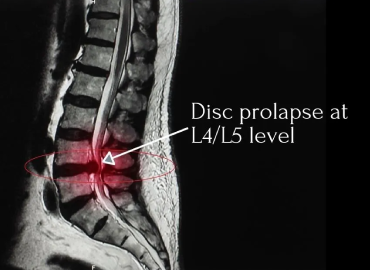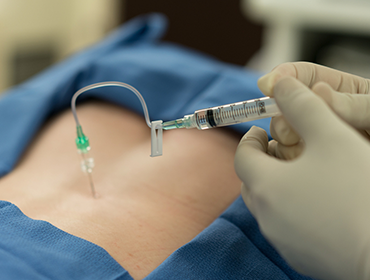Prolapsed Intervertebral Disc
Home / Prolapsed Intervertebral Disc
Prolapsed Intervertebral Disc
Get AppointmentWhat is Prolapsed Intervertebral Disc
A prolapsed intervertebral disc is a technical term for a slipped disc. These discs are placed between each of the vertebrae of the spine and pose as shock absorbers. When the fibrous outer part of the disc breaks, it allows the gel-like core to bulge outwards.
The disc that is damaged then puts pressure on the spinal cord or a single nerve fibre. This means that not only will a slipped disc cause pain in the area of the disc, but also in regions that the nerve controls, such as an arm or a leg. A slipped prolapsed disc can also be a reason for severe lower back pain. The disc presses on a nerve root, which can cause pain and other symptoms in the leg.
Causes:
- Natural ageing
- Less water content in intervertebral discs
- Thinning and weakening of discs
- Smoking
- Obesity
- A fall or blow to the back
Symptoms
Symptoms occur in the back and the area under the nerve root. For example, a slipped disc can arouse pain in the lower back and legs.
- Back pain.
- Nerve root pain.
- Cauda equina syndrome (There’s a collection of nerve roots at the bottom of your spinal cord that affects your legs and bladder. When an injury or herniated disk or other problem compresses those nerves, then that causes pain, weakness, and incontinence).
- Pins and needles (a sensation of uncomfortable tingling or prickling, usually felt in the arms, legs, hands, or feet).
- Uneasiness in part of a buttock, leg, or foot.
Diagnosis
The primary diagnosis is made based on the typical clinical history of local pain in the spine with nerve-related symptoms in the extremities. On physical examination, the spine specialist may also find evidence of nerve stretch and compression signs on the upper/ lower extremity in the form of loss of sensation and muscle weakness. An X-ray is usually done as the first line of investigation to rule out major bone abnormalities. In severe cases which are not responding to medical treatment and physiotherapy, an MRI Scan is done which will show the level and degree of prolapsed disc, and will help the spine specialist determine which kind of treatment will be best for the patient. In certain situations, an EMG-NCV (Electromyography-Nerve Conduction Velocity) is done to assess nerve function. A CT scan is done when a detailed assessment of bone structure is required or when MRI cannot be done.

Prevention
To prevent the occurrence of the disease, there are certain things one should take care of:
- Adopting a healthy lifestyle.
- Exercising regularly.
- Improve the posture.
- Avoiding smoking and alcohol consumption
Treatments:
Treatments for a slipped disc range from conservative to surgical. The treatment typically depends on the level of discomfort you’re experiencing and how far the disc has slipped out of place.
Most people can relieve slipped disc pain using an exercise program that stretches and strengthens the back and surrounding muscles. A physical therapist may recommend exercises that can strengthen your back while reducing your pain. Taking over-the-counter pain relievers and avoiding heavy lifting and painful positions can also help.
While it may be tempting to refrain from all physical activity while you’re experiencing the pain or discomfort of a slipped disc, this can lead to muscle weakness and joint stiffness. Instead, try to remain as active as possible through stretching or low-impact activities such as walking.

If your slipped disc pain does not respond to over-the-counter treatments, your doctor may prescribe stronger medications. These include:
- muscle relaxers to relieve muscle spasms
- narcotics to relieve pain
- nerve pain medications
Your doctor may recommend surgery if your symptoms do not subside in six weeks or if your slipped disc is affecting your muscle function. Your surgeon may remove the damaged or protruding portion of the disc without removing the entire disc. This is called a microdiscectomy (a minimally invasive surgical procedure performed on patients with a herniated lumbar disc. During this surgery, a surgeon will remove portions of the herniated disc to relieve pressure on the spinal nerve column).

GET APPOINTMENT
Schedule Appointment : Your Path to Specialized Care
Get rid of your pain, stress, and enduring with our 24/7 dental services. It's a priority to relieve the pain in surgeon as much as possible. 90% of customers claim that they would come back & recommend us to others.
